Timestamp Estimation in P802.15.4z Amendment †
Abstract
1. Introduction
- -
- demonstrates that the inclusion of lateral lobes with very low power spectral density (−51.3 dBm and −59.3 dBm) in pulse synthesis leads to a pulse with a tighter shape and a steeper rising edge than the pulse recommended by EiR;
- -
- shows that, by a random spreading of STS, that it results in easier extraction of the main lobe by mitigating lateral lobes of cross-correlation.
2. Literature Review
3. UWB Pulse Synthesis
4. Timestamp Estimation in the 802.15.4z Standard
4.1. Timestamp Estimation by Random Spreading of STS
4.2. Sounding the Channel with Multipath Propagation
4.3. Timestamp Estimation in Channel with NLOS and Multipath Propagation
| Algorithm 1: Timestamp estimation in multipath propagation |
| Inputs: STS reference (AES-128 sequence), ; Received STS, |
| 1. Generate locally replica of STS: |
| 2. Compute the received sequence: |
| 3. Timestamp estimation: |
| Output: return |
4.4. Timestamp Estimation in Noisy Channel with NLOS and Multipath Propagation
| Algorithm 2: Timestamp estimation in noisy channel |
| Inputs: STS reference (AES-128 sequence), ; Received STSs, Number of STS, ; |
| 1. Generate locally replica of STS: |
| 2. Compute the received sequences: |
| 3. Average the received sequences: |
| 4. Timestamp estimation: |
| Where is the noise with standard deviation |
| Output: return |
4.5. UWB Channel with Frequency Selective Fading
| Algorithm 3: Timestamp estimation in channel with frequency selective fading |
| Inputs: Ipatov symbol, ; STS, |
| CIR estimation: |
| 1. Lift up the Ipatov symbol on the carrier: |
| 2. Complete the series with zero and perform FFT. |
| 3. Convolve the Ipatov symbol with CIR: |
| 4. CIR estimation by cross-correlation: |
| Timstamp estimation from STS: |
| 5. Shift STS to carrier, complete with zero and perform FFT: |
| 6. Generate locally replica of STS: |
| 7. Simulate the received STS by convolution: |
| 8. Cross-correlation in the frequency domain: |
| 9. Correlation in time domain: |
| Output: return |
5. Results
6. Discussion
Author Contributions
Funding
Acknowledgments
Conflicts of Interest
Appendix A
| Algorithm A: Kolmogorov Factorization |
| Inputs: correlation , psd |
| 1. Inputs test: |
| ? Continue: Goto 3 |
| 2. Compute psd: |
| 3. Compute cepstrum coefficients: |
| 4. Determine imaginary part of log filter by Hilbert transform: |
| 5. Transfer function in frequency domain: |
| 6. Transfer function in time domain of moving average type: |
| 7. Autoregressive function: |
| Outputs: return |
References
- IEEE 802.15 WPAN™ Task Group 4z Enhanced Impulse Radio. Available online: http://www.ieee802.org/15/pub/TG4z.html (accessed on 19 October 2019).
- IEEE Computer Society. IEEE Standard for Low-Rate Wireless Networks Amendment 2: Ultra-Low Power Physical Layer; IEEE Computer Society: Washington, DC, USA, 2016; Volume April. [Google Scholar]
- ETSI. Electromagnetic Compatibility and Radio Spectrum Matters (ERM); Short Range Devices (SRD) using Ultra Wide Band (UWB); Transmission Characteristics; Part 2: UWB Mitigation Techniques; ETSI: Sophia Technology Park, France, 2014. [Google Scholar]
- Luo, C.; Wu, X.; Cao, Y. Multipath interference analysis of IR-UWB systems in indoor office LOS environment. In Proceedings of the 2011 6th International ICST Conference on Communications and Networking in China, CHINACOM 2011, Harbin, China, 17–19 August 2011; pp. 846–850. [Google Scholar]
- Stanciu, M.I.; Azou, S.; Rədoi, E.; Serbənescu, A. A statistical analysis of multipath interference for impulse radio UWB systems. J. Frankl. Inst. 2015, 352, 5952–5967. [Google Scholar] [CrossRef]
- Li, B.; Zhou, Z.; Zou, W.; Li, D.; Zhao, C. Optimal waveforms design for ultra-wideband impulse radio sensors. Sensors 2010, 10, 11038–11063. [Google Scholar] [CrossRef] [PubMed]
- Sharma, A.; Sharma, S.K. Spectral efficient pulse shape design for UWB communication with reduced ringing effect and performance evaluation for IEEE 802.15.4a channel. Wirel. Netw. 2019, 25, 2723–2740. [Google Scholar] [CrossRef]
- Liu, X.; Premkumar, A.B.; Madhukumar, A.S. Pulse shaping functions for UWB systems. IEEE Trans. Wirel. Commun. 2008, 7, 1512–1516. [Google Scholar] [CrossRef]
- Keshavarz, S.N.; Hamidi, M.; Khoshbin, H. A PSO-Based UWB Pulse Waveform Design Method. In Proceedings of the 2010 Second International Conference on Computer and Network Technology, Bangkok, Thailand, 23–25 April 2010; pp. 249–253. [Google Scholar] [CrossRef]
- Ben Issa, D.; Samet, M. Design and Optimization of Dual-Band Energy-Efficient OOK UWB Transmitter Via PSO Algorithm. J. Circuits Syst. Comput. 2019. [CrossRef]
- Wu, X.; Tian, Z.; Davidson, T.N.; Giannakis, G.B. Optimal waveform design for UWB radios. IEEE Trans. Signal Process. 2006, 54, 2009–2021. [Google Scholar] [CrossRef]
- Baranauskas, D.; Zelenin, D. A 0.36W 6b up to 20GS/s DAC for UWB Wave Formation. In Proceedings of the 2006 IEEE International Solid State Circuits Conference—Digest of Technical Papers, San Francisco, CA, USA, 8–10 February 2006; pp. 2380–2389. [Google Scholar] [CrossRef]
- McLaughin, M.; Niewczas, J.; Verso, B. IEEE P802.15-19-0443-01-004z, Text to Address Comment id r1-0820. 2018. Available online: http://www.ieee802.org/15/pub/TG4z.html (accessed on 19 October 2019).
- McLaughin, M.; Hammerschmidt, J.; Ibrahim, B.; Verso, B. IEEE P802.15-20-0089-01-004z, Pulse Shape Text Changes for HRP UWB PHY. 2020. Available online: http://www.ieee802.org/15/pub/TG4z.html (accessed on 1 June 2020).
- Francillon, A.; Danev, B.; Capkun, S. Relay Attacks on Passive Keyless Entry and Start Systems in Modern Cars. Netw. Distrib. Syst. Secur. Symp. 2011, 431–439, 8529521. [Google Scholar]
- Taponecco, L.; Perazzo, P.; D’Amico, A.A.; Dini, G. On the feasibility of overshadow enlargement attack on IEEE 802.15.4a distance bounding. IEEE Commun. Lett. 2014, 18, 257–260. [Google Scholar] [CrossRef]
- Singh, M.; Leu, P.; Capkun, S. UWB with Pulse Reordering: Securing Ranging against Relay and Physical-Layer Attacks. NDSS 2019. [Google Scholar] [CrossRef][Green Version]
- Sedlacek, P.; Slanina, M.; Masek, P. An overview of the IEEE 802.15.4z standard its comparison and to the existing UWB standards. In Proceedings of the 2019 29th International Conference Radioelektronika, RADIOELEKTRONIKA 2019—Microwave and Radio Electronics Week, MAREW, Pardubice, Czech Republic, 16–18 April 2019; pp. 1–6. [Google Scholar] [CrossRef]
- Alarifi, A.; Al-Salman, A.; Alsaleh, M.; Alnafessah, A.; Al-Hadhrami, S.; Al-Ammar, M.A.; Al-Khalifa, H.S. Ultra wideband indoor positioning technologies: Analysis and recent advances. Sensors (Switzerland) 2016, 16, 707. [Google Scholar] [CrossRef]
- Khelifi, F.; Bradai, A.; Benslimane, A.; Rawat, P.; Atri, M. A Survey of Localization Systems in Internet of Things. Mob. Netw. Appl. 2019, 24, 761–785. [Google Scholar] [CrossRef]
- Shit, R.C.; Sharma, S.; Puthal, D.; Zomaya, A.Y. Location of Things (LoT): A review and taxonomy of sensors localization in IoT infrastructure. IEEE Commun. Surv. Tutor. 2018, 20, 2028–2061. [Google Scholar] [CrossRef]
- E Silva, P.F.; Kaseva, V.; Lohan, E.S. Wireless positioning in IoT: A look at current and future trends. Sensors (Switzerland) 2018, 18, 2470. [Google Scholar] [CrossRef] [PubMed]
- Kuutti, S.; Fallah, S.; Katsaros, K.; Dianati, M.; Mccullough, F.; Mouzakitis, A. A Survey of the State-of-the-Art Localization Techniques and Their Potentials for Autonomous Vehicle Applications. IEEE Internet Things J. 2018, 5, 829–846. [Google Scholar] [CrossRef]
- Balico, L.N.; Loureiro, A.A.F.; Nakamura, E.F.; Barreto, R.S.; Pazzi, R.W.; Oliveira, H.A.B.F. Localization prediction in vehicular Ad hoc networks. IEEE Commun. Surv. Tutor. 2018, 20, 2784–2803. [Google Scholar] [CrossRef]
- Del Peral-Rosado, J.A.; Seco-Granados, G.; Kim, S.; López-Salcedo, J.A. Network Design for Accurate Vehicle Localization. IEEE Trans. Veh. Technol. 2019, 68, 4316–4327. [Google Scholar] [CrossRef]
- Scharf, L. Statistical Signal Processing: Detection, Estimation and Time Series Analysis, 1st ed.; Addison-Wesley Publishing Company, Inc.: Boston, MA, USA, 1991; pp. 424–429. ISBN 0-201-19038-9. [Google Scholar]
- Qi, Y.; Kobayashi, H.; Suda, H. On time-of-arrival positioning in a multipath environment. IEEE Trans. Veh. Technol. 2006, 55, 1516–1526. [Google Scholar] [CrossRef]
- Álvarez, R.; Díez-González, J.; Alonso, E.; Fernández-Robles, L.; Castejón-Limas, M.; Perez, H. Accuracy Analysis in Sensor Networks for Asynchronous Positioning Methods. Sensors 2019, 19, 3024. [Google Scholar]
- Niewczas, J.; Verso, B.; Fagan, T.; Leong, F.; Hammerschmidt, J.; Ibrahim, B.; Sasoglu, E.; Knobloch, D.; Reisinger, T. IEEE P802.15-19-0134-00-004z, Security vs. Sequence Length Considerations. 2019. Available online: http://www.ieee802.org/15/pub/TG4z.html (accessed on 21 October 2019).
- Verso, B.; Leong, F.; Hammerschmidt, J.; Niewczas, J.; Ibrahim, B.; Shah, T.; Reisinger, T.; Daniel Knobloch, D. IEEE P802.15-18-0477-00-004z, HRP UWB PHY Enhanced Mode Converged Consensus. 2018. Available online: http://www.ieee802.org/15/pub/TG4z.html (accessed on 19 October 2019).
- Molisch, A.F.; Cassioli, D.; Chong, C.C.; Emami, S.; Fort, A.; Kannan, B.; Karedal, J.; Kunisch, J.; Schantz, H.G.; Siwiak, K.; et al. A comprehensive standardized model for ultrawideband propagation channels. IEEE Trans. Antennas Propag. 2006, 54, 3151–3166. [Google Scholar] [CrossRef]
- Li, X.; Fan, P.; Mow, W.H. Existence of ternary perfect sequences with a few zero elements. In Proceedings of the 5th International Workshop on Signal Design and Its Applications in Communications, IWSDA’11, Guilin, China, 10–14 October 2011; pp. 88–91. [Google Scholar]
- Kram, S.; Stahlke, M.; Feigl, T.; Seitz, J.; Thielecke, J. UWB channel impulse responses for positioning in complex environments: A detailed feature analysis. Sensors (Switzerland) 2019, 19, 5547. [Google Scholar] [CrossRef]
- Nwadiugwu, W.P.; Kim, D.S. Ultrawideband Network Channel Models for Next-Generation Wireless Avionic System. IEEE Trans. Aerosp. Electron. Syst. 2020, 56, 113–129. [Google Scholar] [CrossRef]
- International Telecommunication Union (ITU). Presentation: Advanced wireless technologies and spectrum management. In Radio Spectrum Management for a Converging World; ITU: Geneva, Switzerland, 2004; Available online: http://handle.itu.int/11.1002/pub/800c7e3d-07f64a9d-en (accessed on 25 October 2019).
- Otim, T.; Díez, L.E.; Bahillo, A.; Lopez-Iturri, P.; Falcone, F. Effects of the body wearable sensor position on the UWB localization accuracy. Electronics 2019, 8, 1351. [Google Scholar] [CrossRef]
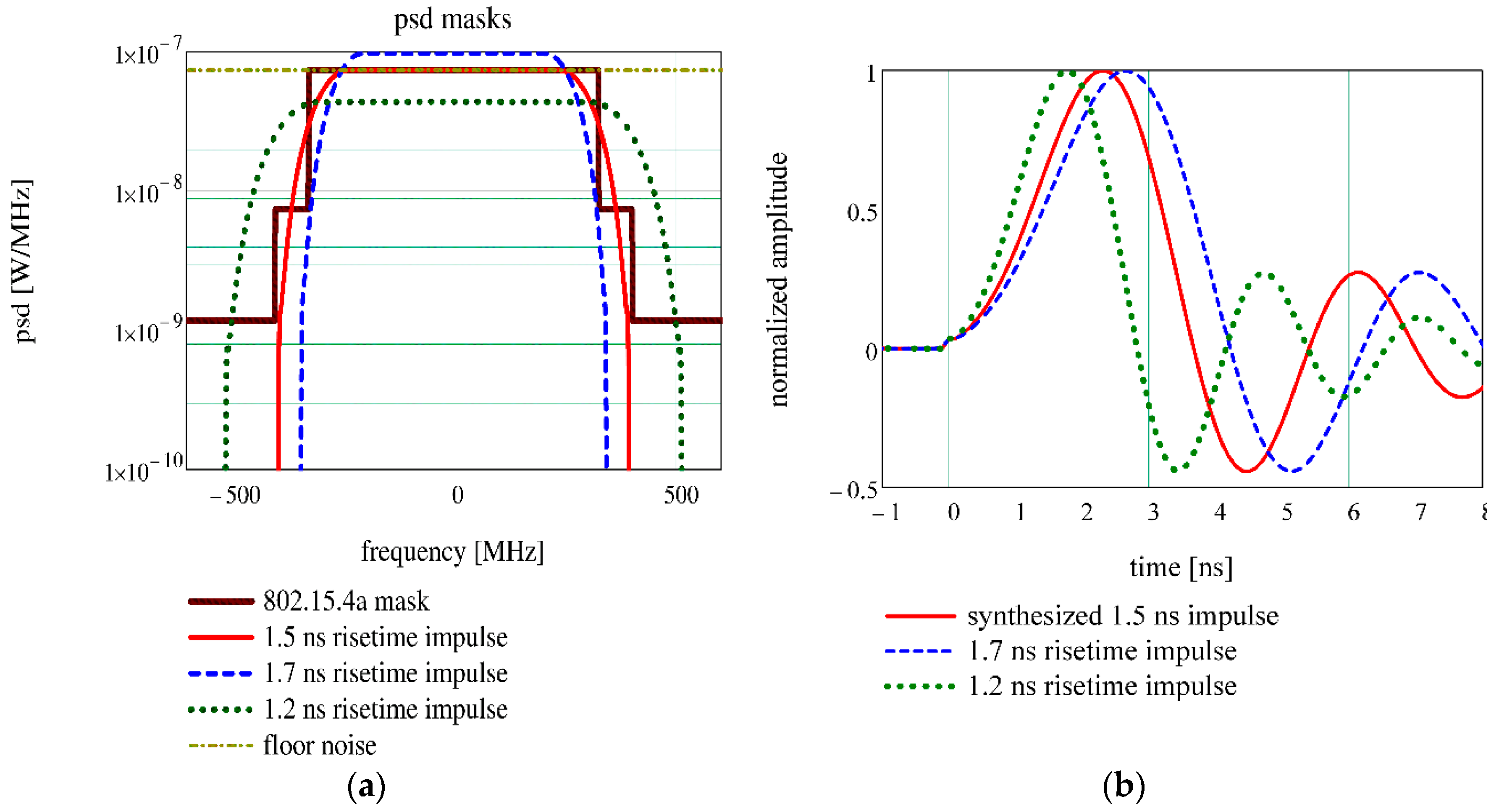
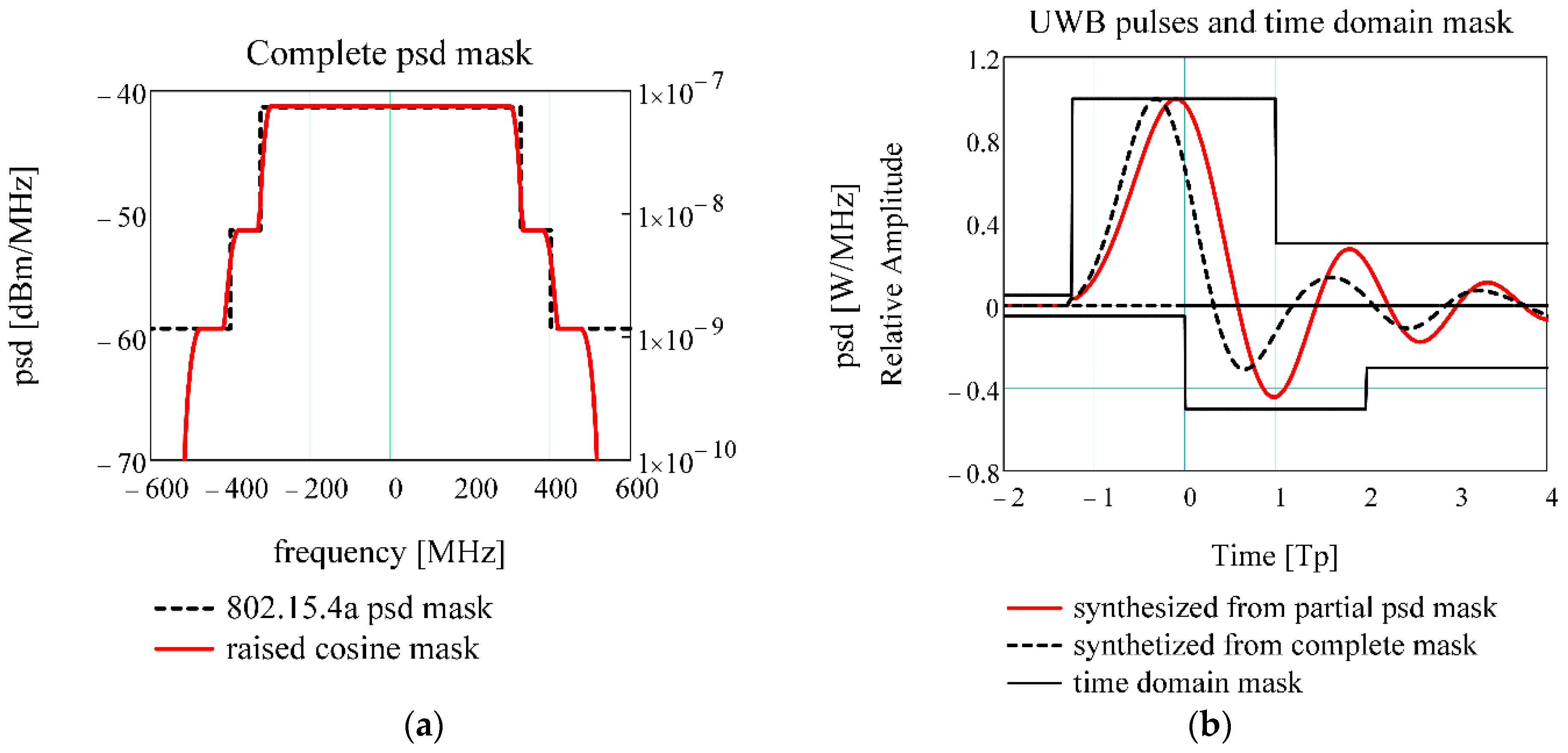

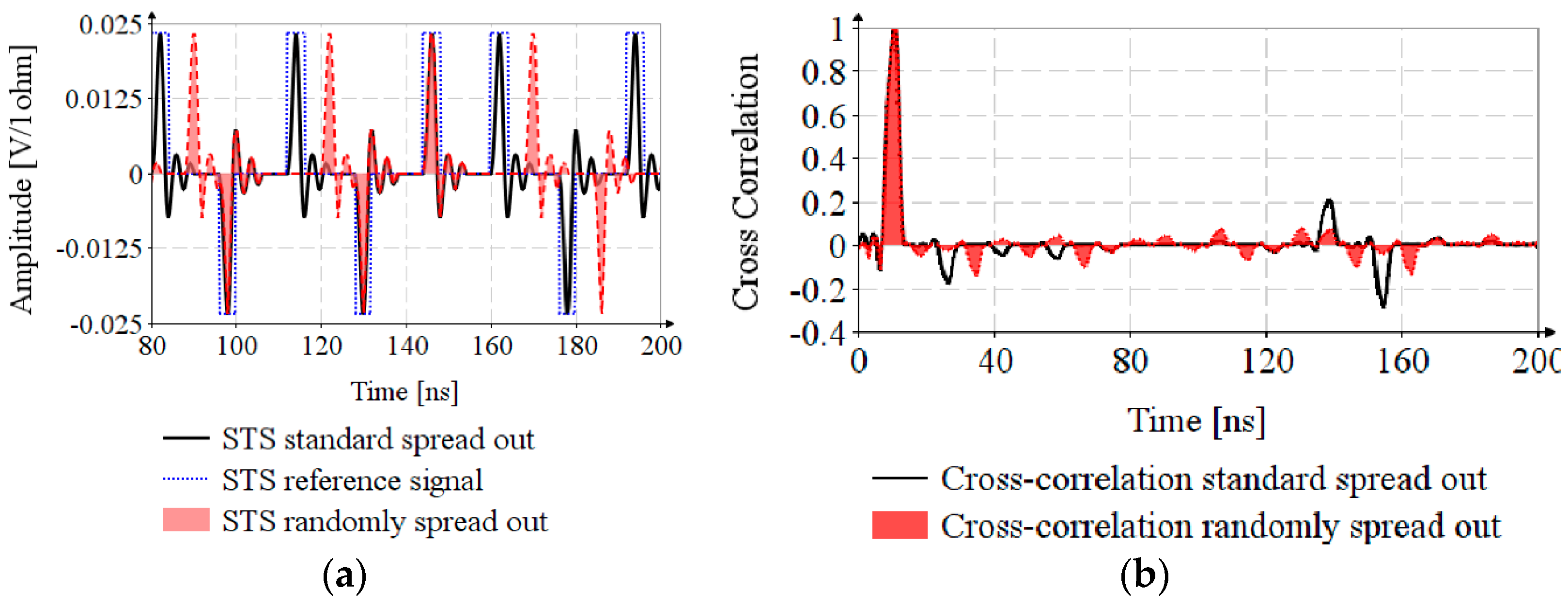
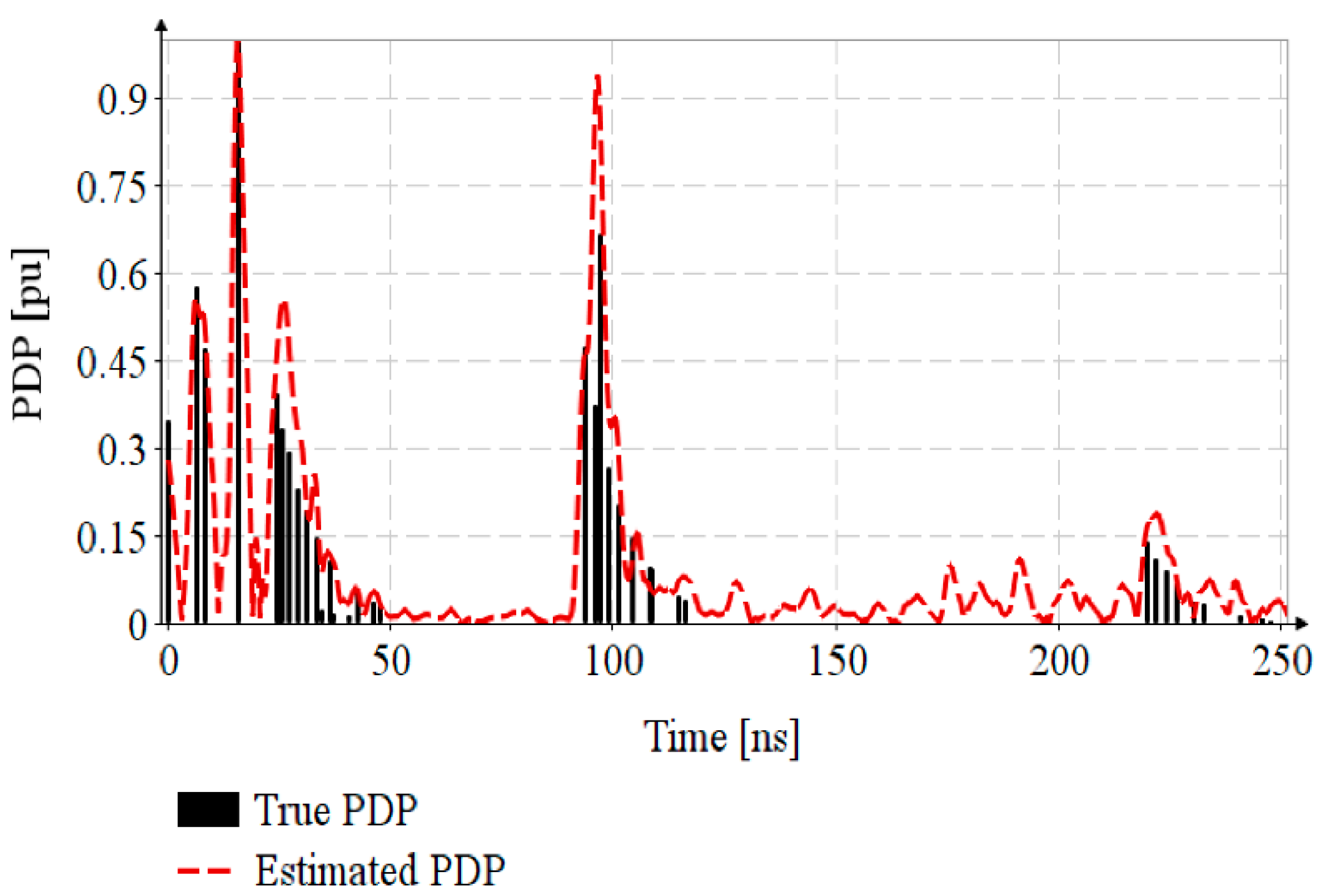
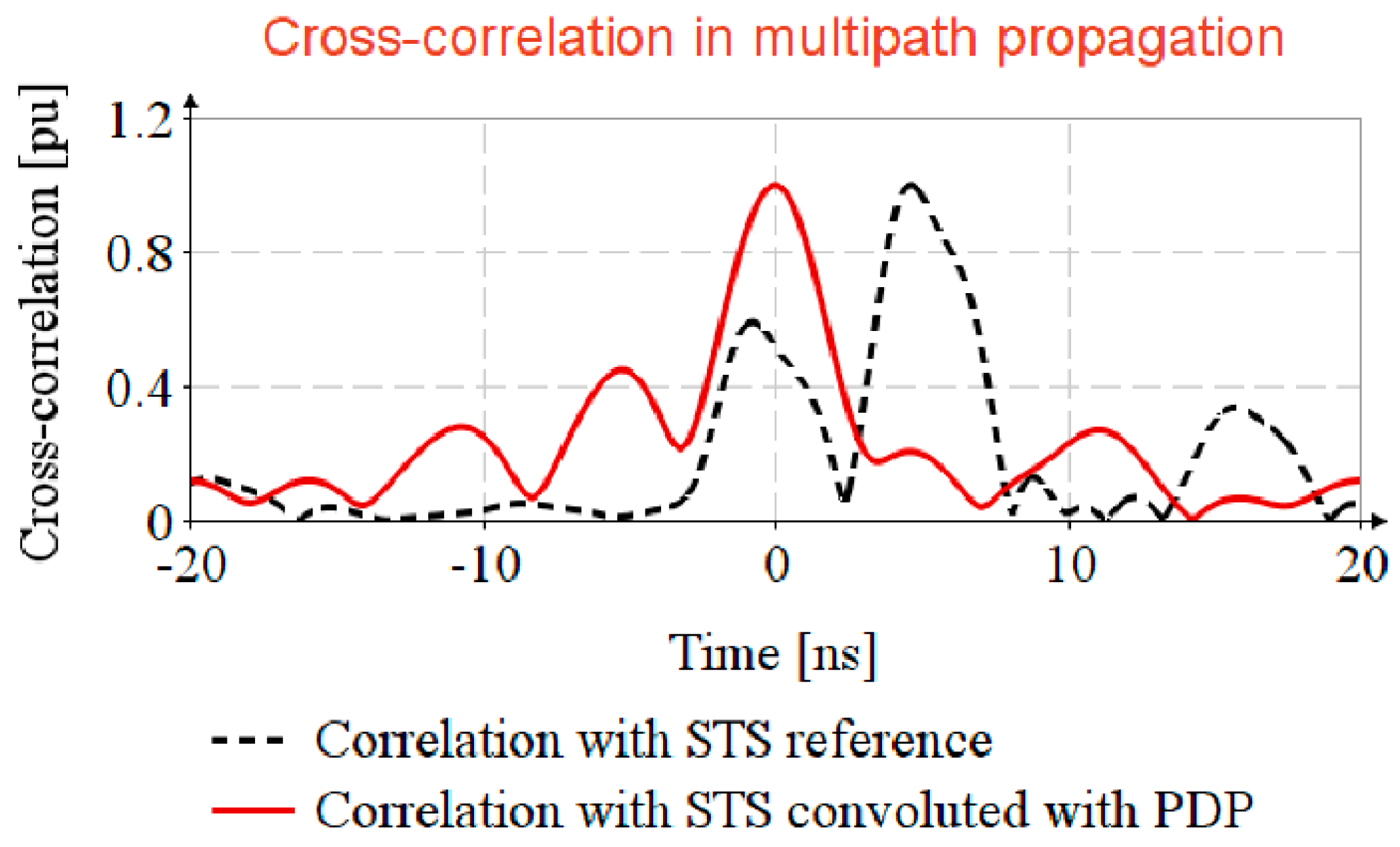
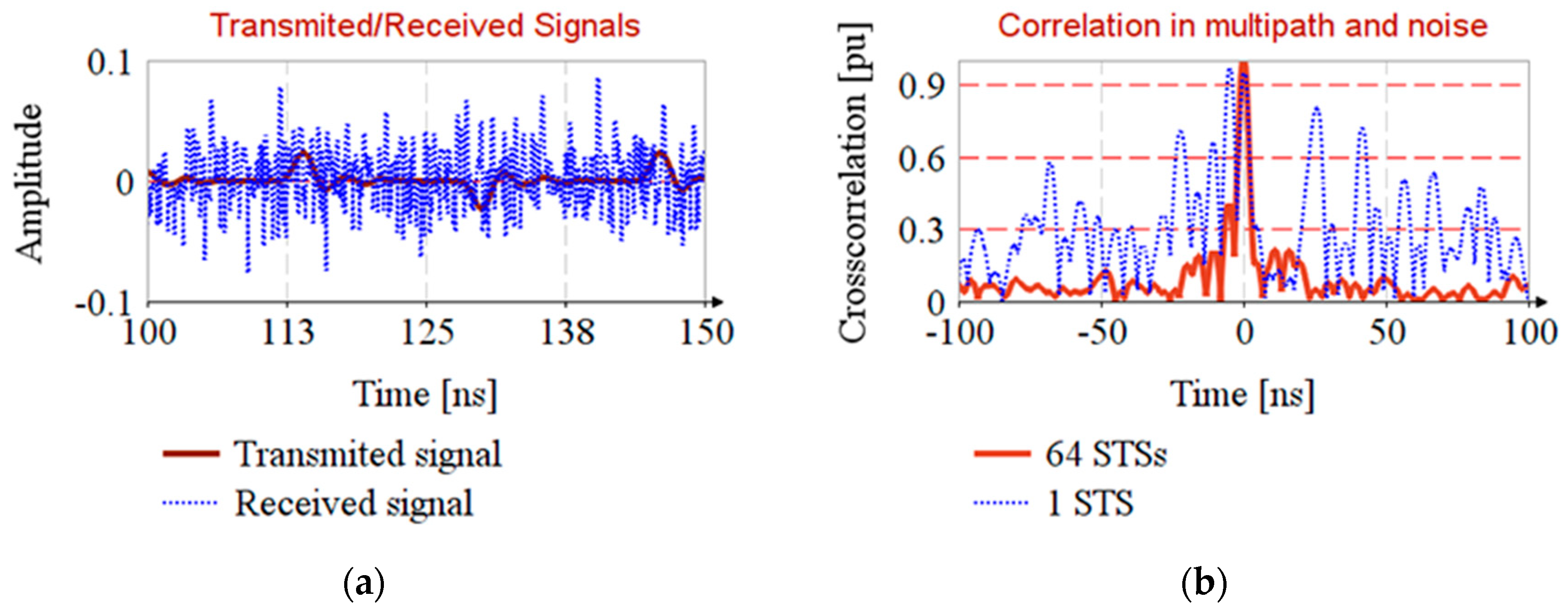
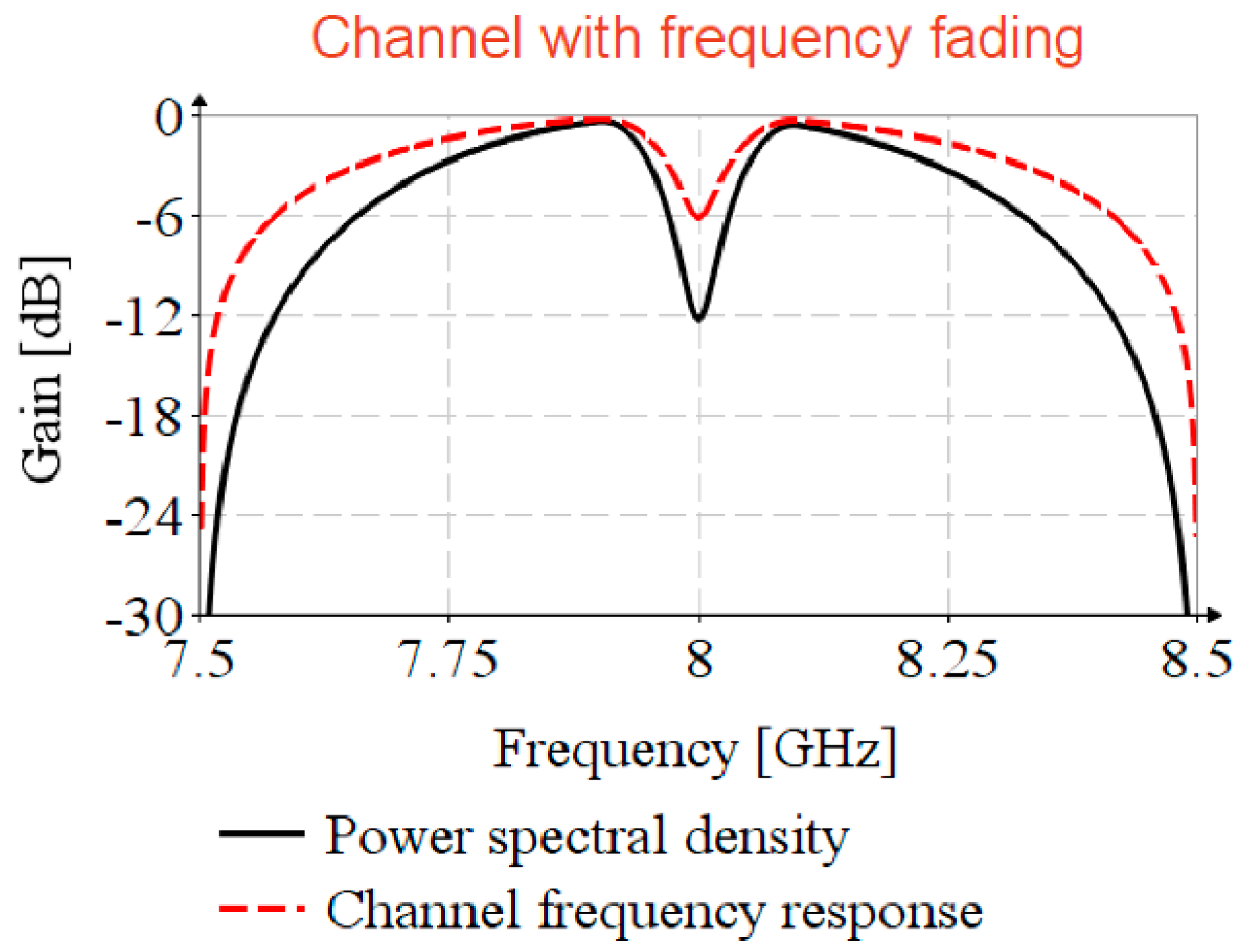
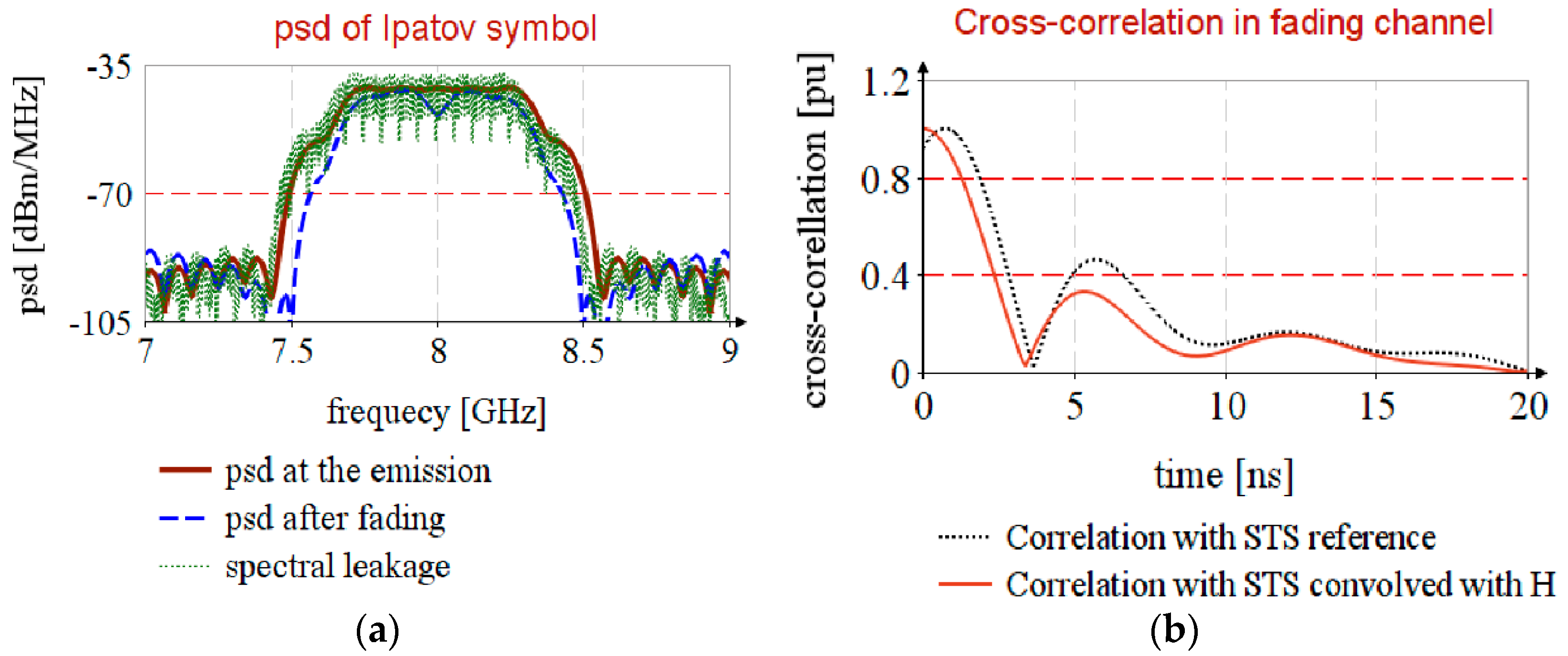

| Synthesis Method | Bandwidth β [MHz] | NESP [%] | Risetime [ns] | Amplitude [V] |
|---|---|---|---|---|
| 802.15.4z reference pulse [11] | 533 | 94.5 | 1.5 | 0.164 |
| Pulse synthesized from entire spectral mask (Figure 2a) | 535 | 98.5 | 1.2 | 0.187 |
| Name [unit] | Symbol | Value |
|---|---|---|
| Path gain: | ||
| Reference distance [m] | 1 | |
| Gain at reference distance [dB] | −73 | |
| Path gain exponent | 2.5 | |
| Frequency decaying factor | 0.13 | |
| Power delay profile: | ||
| Expected number of clusters | 10.5 | |
| Clusters arrival rate [1/ns] | 0.0243 | |
| Clusters decay time constant [ns] | 104.7 | |
| Rays arrival rate [1/ns] | 0.223 | |
| Intracluster decay time constant [ns] | 9.3 | |
| First path attenuation | 0.65 | |
| Path increase time constant [ns] | 5 |
| Synthesis Method | Bandwidth β [GHz] | NESP [%] |
|---|---|---|
| Pulse synthesized from entire spectral mask (Figure 2a) | 0.537 | 98.5 |
| Gaussian with NESP maximization [6] | 7.160 | 98.7 |
| Linear combination of Gaussian pulses [8] | 7.200 | 91 |
| VC oscillator with PSO optimization [10] | 1.332 | |
| Gaussian with semidefinite programing [11] | 12 | 85.5 |
| Distance [m] | 1 | 10 | 20 | 40 | 80 | 160 |
|---|---|---|---|---|---|---|
| SNR [dB] | −10.2 | −27.8 | −33.1 | −38.4 | −43.7 | −49 |
| CRLB [m] | 0.1665 | 2.31 | 4.25 | 7.78 | 14.33 |
© 2020 by the authors. Licensee MDPI, Basel, Switzerland. This article is an open access article distributed under the terms and conditions of the Creative Commons Attribution (CC BY) license (http://creativecommons.org/licenses/by/4.0/).
Share and Cite
Domuta, I.; Palade, T.P.; Puschita, E.; Pastrav, A. Timestamp Estimation in P802.15.4z Amendment. Sensors 2020, 20, 5422. https://doi.org/10.3390/s20185422
Domuta I, Palade TP, Puschita E, Pastrav A. Timestamp Estimation in P802.15.4z Amendment. Sensors. 2020; 20(18):5422. https://doi.org/10.3390/s20185422
Chicago/Turabian StyleDomuta, Ioan, Tudor Petru Palade, Emanuel Puschita, and Andra Pastrav. 2020. "Timestamp Estimation in P802.15.4z Amendment" Sensors 20, no. 18: 5422. https://doi.org/10.3390/s20185422
APA StyleDomuta, I., Palade, T. P., Puschita, E., & Pastrav, A. (2020). Timestamp Estimation in P802.15.4z Amendment. Sensors, 20(18), 5422. https://doi.org/10.3390/s20185422






